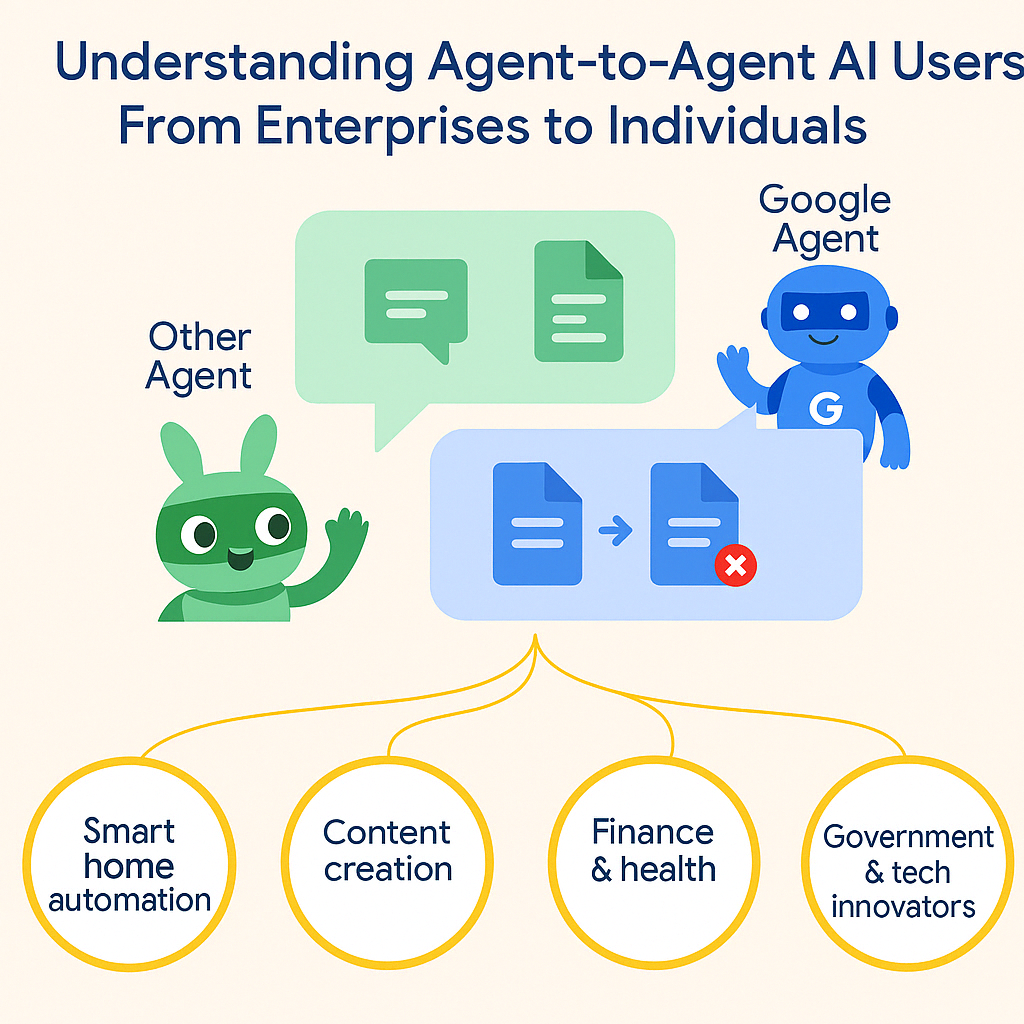🤖 What Is Agent-to-Agent (A2A) AI?
Agent-to-Agent AI, or A2A AI, allows autonomous systems to communicate, share data, and make decisions without human input. It’s a futuristic concept—but it’s already being used today.
Think of it as machines talking to machines to complete tasks faster, smarter, and more efficiently.
🎯 Who Is the Target User for Agent-to-Agent (A2A) AI?

🔹 1. Enterprises and Industries
Large-scale businesses benefit the most from A2A AI’s ability to handle complex, real-time coordination:
- Logistics: Warehouse robots sync with delivery routing systems.
- Healthcare: Radiology AI communicates with diagnostic agents for better accuracy.
- Finance: Risk analysis tools and fraud detection systems collaborate to spot suspicious activity.
These organizations rely on A2A to boost speed, cut costs, and reduce errors.
🔹 2. Developers & Tech Innovators
For AI engineers and system designers, A2A is a dream come true. They use it to:
- Create smarter automation pipelines
- Simulate complex systems like smart traffic
- Build scalable ecosystems of smart devices
Platforms like Google A2A GitHub provide open-source protocols for developers to start building multi-agent systems. (👨💻 Developers—start tinkering here!)
🔹 3. Governments and Smart Cities
A2A is also entering the public sector:
- Urban Planning: Traffic lights, buses, and utilities coordinate automatically.
- Emergency Response: AI agents across departments coordinate real-time decisions.
Governments use A2A to optimize city infrastructure, save lives, and reduce human error.
💡 How Can an Individual Utilize A2A AI?
You might think A2A is only for tech giants, but individuals can benefit too—especially as low-code tools make it accessible.
✅ 1. Smart Home Automation
Connect your smart devices using platforms like Home Assistant or Matter.
Example:
- Your smart lock (Agent 1) notices you’ve left the house.
- It notifies the thermostat (Agent 2) to turn off the heat.
Voilà—A2A at home.
✅ 2. Content Creation & Workflow Chaining
Use tools like Zapier, Make.com, or AutoGPT to mimic agent workflows:
- Agent 1 summarizes your emails
- Agent 2 drafts replies
- Agent 3 schedules them on your calendar
This gives creators and freelancers a way to boost productivity using AI that acts like a team.
✅ 3. Personal Finance
Apps are already syncing budgeting tools (Agent 1) with fraud alert systems (Agent 2) to notify you faster and smarter.
✅ 4. Health Monitoring
Your smartwatch (Agent 1) detects an abnormal heartbeat. It sends this to a health app (Agent 2), which alerts a virtual assistant (Agent 3).
A2A makes personal wellness smarter, faster, and proactive.
🧩 Conclusion: Agent-to-Agent Isn’t Just for Enterprises Anymore
A2A AI started in big industries, but it’s trickling down into everyday life. Whether you’re optimizing a smart home or chaining content tools, Agent-to-Agent systems are quietly changing how we live.
The best part? You don’t need to be a developer to benefit from it.
👉 Curious how A2A works behind the scenes? Read our main post on The Power of Agent-to-Agent AI.
📎 External Link: Google A2A GitHub – Developer Tools and Protocols
📘 Glossary
- Agent-to-Agent AI – AI systems that directly communicate to complete tasks.
- Smart Home Automation – Devices that coordinate via AI.
- Multi-Agent System – Several autonomous agents working together.
- Workflow Chaining – A sequence of AI tasks connecting services.
- No-Code Tools – Apps that let users build automation without programming.
